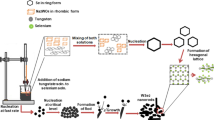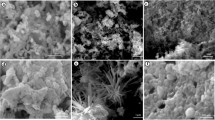Abstract
The current environmental and energy concerns at global level drive toward politics of sustainable development for a green economy growth. In this scenario, chemical sensors play an important role in regulating energetic, ecological, and productive efficiency because of their excellent potential to develop technology for online gas emissions monitoring and feedback system control. Since sensor performances are affected by size, morphology, crystalline structure, and stoichiometry of the sensing materials, the aim of this work is to study how the synthesis conditions affect the properties of sensing nanoparticles of strontium titanate perovskite oxide and develop mathematical models with predictive ability for the design of materials. The investigated ranges of operating conditions were pH levels from 2 to 12; CA/NO3 molar ratio from 0.09 to 0.17; CA/M molar ratio from 0.63 to 2.00, where CA, NO3, and M terms are related to citric acid, nitrate ions, and the total metals, including strontium and titanium. The results confirm that fuel-to-oxidizer molar ratio of the initial solution affects the properties of the synthesized nanopowder because of its significant effects on flame temperature, burning rate, and reaction time. Depending on the synthesis conditions, the crystallite size changes from 10 to 30 nm and the grain size from 20 to 50 nm. From reacting solution with stoichiometric amounts of fuels and oxidizers, it was obtained more crystalline, pure, and nanosized perovskite oxide powder. In addition, the solution acidity and the complexing agent amount affects the dissolution of metal ions, reflecting upon the homogeneity of the dried gel and the characteristics of the final products in turn. Finally, a quality by design approach, using multiple regression analysis, was successfully used to study the combustion synthesis process by defining the direct and indirect effects of pH, CA/NO3, and CA/M on synthesized nanomaterial properties.





















Similar content being viewed by others
References
Deptula A, Milkowska M, Lada W, Olczak T, Wawszczak D, Smolinski T, Brykala M, Chmielewski A, Zaza F, Goretta K (2012) Vitrification of nuclear wastes by complex sol–gel process. Adv Mater Res 518–523:3216–3220
Smolinski T, Deptula A, Olczak T, Lada W, Brykala M, Wojtowicz P, Wawszczak D, Rogowski M, Zaza F (2014) Perovskite synthesis via complex 26 sol–gel process to immobilize radioactive waste elements. J Radio Nucl Chem 299(1):675–680
Frangini S, Masci A, McPhail S, Soccio T, Zaza F (2014) Degradation behavior of a commercial 13Cr ferritic stainless steel (SS405) exposed to an ambient air atmosphere for IT-SOFC interconnect applications. Mater Chem Phys 144(3):491–497
Zaza F, Pasquali M, Simonetti E, Paoletti C, Dell’Era A (2013) Innovative nanomaterials for fuel cells fed with biogas. Nuovo Cimento Soc Ital Fis C 36(2):73–81
Devianto H, Simonetti E, McPhail S, Zaza F, Cigolotti V, Paoletti C, Moreno A, La Barbera A, Luisetto I (2012) Electrochemical impedance study of the poisoning behaviour of Ni-based anodes at low concentrations of H2S in an MCFC. Int J Hydrog Energy 37(24):19312–19318
Frangini S, Zaza F, Masci A (2012) Molten carbonate corrosion of a 13-Cr ferritic stainless steel protected by a perovskite conversion treatment: relationship with the coating microstructure and formation mechanism. Corros Sci 62:136–146
Frangini S, Masci A, Zaza F (2011) Molten salt synthesis of perovskite conversion coatings: a novel approach for corrosion protection of stainless steels in molten carbonate fuel cells. Corros Sci 53(8):2539–2548
Zaza F, Paoletti C, Lopresti R, Simonetti E, Pasquali M (2011) Multiple regression analysis of hydrogen sulphide poisoning in molten carbonate fuel cells used for waste-to-energy conversions. Int J Hydrog Energy 36(13):8119–8125
Pozio A, Cemmi A, Carewska M, Paoletti C, Zaza F (2010) Characterization of gas diffusion electrodes for polymer electrolyte fuel cells. J Fuel Cell Sci Technol 7(4):0410031–0410037
Zaza F, Paoletti C, LoPresti R, Simonetti E, Pasquali M (2010) Studies on sulfur poisoning and development of advanced anodic materials for waste-to-energy fuel cells applications. J Power Sources 195(13):4043–4050
Ciccoli R, Cigolotti V, Lo Presti R, Massi E, McPhail S, Monteleone G, Moreno A, Naticchioni V, Paoletti C, Simonetti E, Zaza F (2010) Molten carbonate fuel cells fed with biogas: combating H2S. Waste Manag 30(6):1018–1024
Paoletti C, Zaza F, Carewska M, LoPresti R, Simonetti E (2010) Performance study of nickel covered by lithium cobaltite cathode for molten carbonate fuel cells: a comparison in Li/K and Li/Na carbonate melts. J Fuel Cell Sci Technol 7(2):0210081–0210085
Paoletti C, Carewska M, Presti R, Phail S, Simonetti E, Zaza F (2009) Performance analysis of new cathode materials for molten carbonate fuel cells. J Power Sources 193(1):292–297
Pozio A, Zaza F, Masci A, Silva R (2008) Bipolar plate materials for PEMFCs: a conductivity and stability study. J Power Sources 179(2):631–639
Zaza F, Frangini S, Leoncini J, Luisetto I, Masci A, Pasquali M, Tuti S (2014) Temperature-independent sensors based on perovskite-type oxides. In: AIP conference proceedings, vol 1603, pp 53–61
Zaza F, Pallozzi V, Serra E, Pasquali M (2015) Combustion synthesis of LaFeO3 sensing nanomaterial. In: AIP conference proceedings, vol 1667, p 020003
Zaza F, Orio G, Serra E, Caprioli F, Pasquali M (2015) Low-temperature capacitive sensor based on perovskite oxides. In: AIP conference proceedings, vol 1667, p 020004
Sekhar P, Brosha E, Mukundan R, Garzon F (2010) Chemical sensors for environmental monitoring and homeland security. Electrochem Soc Interface 19(4):35–40
Hulanicki A, Glab S, Ingman F (1991) Chemical sensors definitions and classification. Pure Appl Chem 63(9):1247–1250
Capone S, Forleo A, Francioso L, Rella R, Siciliano P, Spadavecchia J, Presicce D, Taurino A (2003) Solid state gas sensors: state of the art and future activities. J Optoelectron Adv Mater 5(5):1335–1348
Batzill M, Diebold U (2005) The surface and materials science of tin oxide. Prog Surf Sci 79(2–4):47–154
Barsan N, Schweizer-Berberich M, Gopel W (1999) Fundamental and practical aspects in the design of nanoscaled SnO2 gas sensors: a status report. Fresenius J Anal Chem 365(4):287–304
Gopel W, Schierbaum K (1995) SnO2 sensors: current status and future prospects. Sens Actuators B 26(1–3):1–12
Orton J, Powell M (1980) The hall effect in polycrystalline and powdered semiconductors. Rep Prog Phys 43(11):1263–1307
Rothschild A, Komem Y (2004) The effect of grain size on the sensitivity of nanocrystalline metal-oxide gas sensors. J Appl Phys 95(11I):6374–6380
Kim I-D, Rothschild A, Tuller H (2013) Advances and new directions in gas-sensing devices. Acta Mater 61(3):974–1000
Korotcenkov G (2007) Metal oxides for solid-state gas sensors: what determines our choice? Mater Sci Eng B 139(1):1–23
Kajale D, Patil G, Gaikwad V, Shinde S, Chavan D, Pawar N, Shirsath S, Jain G (2012) Synthesis of SrTiO3 nanopowder by sol–gel-hydrothemal method for gas sensing application. Int J Smart Sens Intell Syst 5(2):382–400
Biskupski D, Geupel A, Wiesner K, Fleischer M, Moos R (2009) Platform for a hydrocarbon exhaust gas sensor utilizing a pumping cell and a conductometric sensor. Sensors 9(9):7498
Inoue T, Seki N, Kamimae J-I, Eguchi K, Arai H (1991) The conduction mechanism and defect structure of acceptor- and donor-doped SrTiO3. Solid State Ion 48(3–4):283–288
Korotcenkov G (2005) Gas response control through structural and chemical modification of metal oxide films: state of the art and approaches. Sens Actuators B 107(1 SPEC.ISS):209–232
Mukasyan A, Epstein P, Dinka P (2007) Solution combustion synthesis of nanomaterials. In: Proceedings of the combustion institute, vol 31(II), pp 1789–1795
Sutka A, Mezinskis G (2012) Sol–gel auto-combustion synthesis of spinel-type ferrite nanomaterials. Front Mater Sci 6(2):128–141
Lundstedt T, Seifert E, Abramo L, Thelin B, Nystrm A, Pettersen J, Bergman R (1998) Experimental design and optimization. Chemom Intell Lab Syst 42(1–2):3–40
Martell A, Smith R (1977) Other Organic Ligands. Critical stability constants, vol 3. Springer, New York, p 495
Dean J (1999) Lange’s handbook of chemistry. McGraw-Hill, New york
Lide D (2005) Handbook of chemistry and physics. CRC Press, Boca Raton
Martell A, Smith R (1976) Inorganic complexes. Critical stability constants, vol 4. Springer, New York
Collins JM, Uppal R, Incarvito CD, Valentine AM (2005) Titanium(IV) citrate speciation and structure under environmentally and biologically relevant conditions. Inorg Chem 44(10):3431–3440
Jin-Ho C, Yang-Su H, Seung-Wan S (1994) Preparation and magnetic properties of ultrafine SrFe12O19 particles derived from a metal citrate complex. Mater Lett 19(56):257–262
Barbooti MM, Al-Sammerrai DA (1986) Thermal decomposition of citric acid. Thermochim Acta 98:119–126
Vajargah SH, Hosseini HM, Nemati Z (2006) Synthesis of nanocrystalline yttrium iron garnets by solgel combustion process: the inuence of pH of precursor solution. Mater Sci Eng B 129(13):211–215
Mali A, Ataie A (2005) Inuence of Fe/Ba molar ratio on the characteristics of Ba-hexaferrite particles prepared by solgel combustion method. J Alloy Compd 399(12):245–250
Hong Y, Ho C, Hsu H, Liu C (2004) J Magn Magn Mater 279(23):401–410
Guo X, Ravi B, Devi P, Hanson J, Margolies J, Gambino R, Parise J, Sampath S (2005) Synthesis of yttrium iron garnet (YIG) by citratenitrate gel combustion and precursor plasma spray processes. J Magn Magn Mater 295(2):145–154
Roy S, Sigmund W, Aldinger F (1999) Nanostructured yttria powders via gel combustion. J Mater Res 14:1524–1531
Glassman I, Yetter R (2008) Combustion. Academic Press, San Diego
Smith K, Smoot L, Fletcher T, Pugmire R (1994) The structure and reaction processes of coal. Springer, New York
Law C (2006) Combustion Physics. Cambridge University Press, New York
Goldschmidt VM (1926) Die gesetze der krystallochemie. Naturwissenschaften 14(21):477–485
Pielaszek R, Lojkowski W, Matysiak H, Wejrzanowski T, Opalinska A, Fedyk R, Burjan A, Proykova A, Iliev H (2006) Chapter 5: Characterisation of particle size in nanopowders and bulk nanocrystalline materials. In: Lojkowski W, Turan R, Proykova A, Daniszewska A (eds) Nanometrology. European Nanotechnology Gateway, Eight Nanoforum Report. http://nanoparticles.org/pdf/nanometrology.pdf
Lehrbuch E (1912) Chemische technologie in einzeldarstellungen. Springer, New York
Stokes A, Wilson A (1944) The diffraction of X rays by distorted crystal aggregates. In: Proceedings of the physical society 56(3) pp 174–181
Williamson G, Hall W (1953) X-ray line broadening from filed aluminium and wolfram. Acta Metall 1(1):22–31
Abraham C, Joseph R, Nattamai B (eds) (2009) Principles and applications of powder diffraction. Wiley, Weinheim
Acknowledgements
The authors would like to express their gratitude to the ENEA Research Centre and La Sapienza University.
Author information
Authors and Affiliations
Corresponding author
Rights and permissions
About this article
Cite this article
Zaza, F., Orio, G. & Serra, E. Quality by design approach for SrTiO3 perovskite nanomaterials synthesis. J Mater Sci 51, 9649–9668 (2016). https://doi.org/10.1007/s10853-016-0198-8
Received:
Accepted:
Published:
Issue Date:
DOI: https://doi.org/10.1007/s10853-016-0198-8




